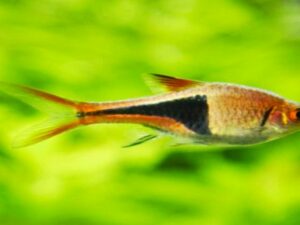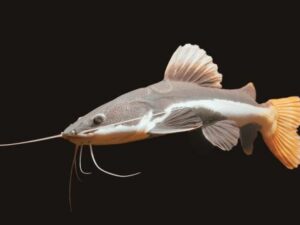The electric blue acara is a beautiful fish found in the aquarium trade. They get their name because of their gorgeous blue and silver color.
They are peaceful fish that can do well in community and single-species tanks. They are famous for beginner aquarists because they are hardy and relatively easy to care for.
This guide will teach you how to care for your electric blue acara. You will learn about the water quality they need, the tank size they require, and the decorations they like. You will also learn about the filtration methods that are best for them.
We will also discuss the Electric Blue Acara’s diet, habitat, and care requirements. We will also provide some tips on how to keep them healthy and happy in your aquarium. So, if you want a beautiful fish to add to your tank, the electric blue acara is an excellent choice.
Table of Contents
- Electric Blue Acara: Species Summary
- Feeding Frequency
- Feeding Methods
- Tank Size
- Filtration
- Substrate and Gravel
- Ammonia Levels and Nitrite Levels
- Protein Skimmer
- Transportation and Handling
- Tank Mates
- Breeding
- How many electric blue Acaras can be kept in one tank?
- Diseases They Can Have
- How to Treat Diseases?
- Advantages of having them in your tank
- Disadvantages of having them in your tank
- Conclusion
Electric Blue Acara: Species Summary
| Scientific Name | Aequidens coeruleopunctatus |
| Common Name | Electric blue acara |
| Origin: | South America |
| Family | Cichlidae |
| Size | Elmore |
| Lifespan | 8 to 10 years |
| Genus: | Aequidens |
| Species: | coeruleopunctatus |
| Minimum tank size | 30 gallons or larger |
| Activity Level | Peaceful |
| Diet | Omnivorous |
| Cost: | Low |
| Care level: | Easy |
Electric Blue Acara: Appearance
The electric blue acara is a beautiful fish with striking blue and silver markings. Their fins are black and have a black spot on their dorsal.
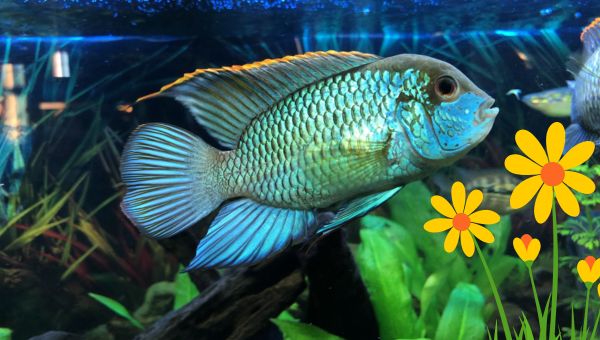
Their body is silver, and their belly is a pale blue. Their shape is compressed and elongated. They have faded yellow eyes. They look stunning when schooling with other brightly colored fish.
Electric Blue Acara: Origin and Distribution
The electric blue acara is a tropical fish from the Amazon River basin in South America. They are found in the lower reaches of the river and its tributaries.
They can be found in both slow-moving and fast-moving water habitats. Around the world, they are found in countries like Columbia, Peru, and Brazil.
Habitat
The electric blue acara is a fish that prefers to live in schools. They are found in slow-moving water habitats such as blackwater streams, creeks, and tributaries in the wild.
They inhabit areas with dense vegetation where they can find cover from predators. They also prefer places with a lot of organic matter in the water, providing them with a food source. The electric blue acara can do well in the aquarium in a community or single-species tank.
Adult Size
The adult size of the electric blue acara is about 6 to 7 inches. The males are usually a little bit smaller than the females.
Behavior
The electric blue acara is a very active fish. They will dart around the tank and explore all the nooks and crannies. They are also very territorial and will defend their territory against other fish. Their behavior towards humans is usually amiable.
They will often come up to the side of the tank to greet you.
Sexing
Its color can sex the electric blue acara. The males are a brighter blue than the females. They will also have a black spot on their dorsal fin.
Another way of knowing is to look at the fish’s anal fin. The male’s anal fin will be pointed, while the female will be rounded.
Electric Blue Acara: Lifespan
The electric blue acara is a carnivorous fish that eats various things in the wild. In the wild, they eat small fish, insects, crustaceans, and other invertebrates. They will also eat algae and plant matter. In captivity, the electric blue acara can be fed various foods.
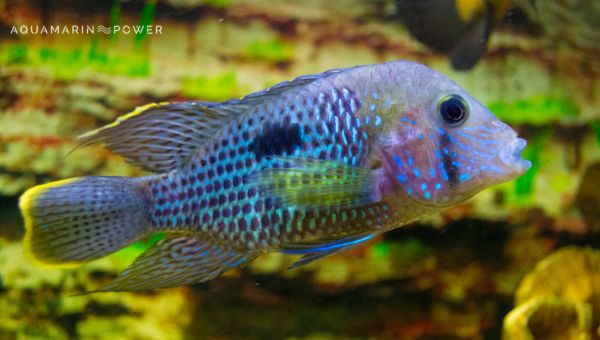
They can be fed a diet of live or frozen brine shrimp, bloodworms, daphnia, and krill. They can also be fed a diet of pellets, flakes, and freeze-dried foods. Providing them with various foods is essential to ensure they get all the necessary nutrients.
Feeding Frequency
Electric blue acaras should be fed a small amount of food twice daily. This will help keep their tank clean and minimize the risk of water quality problems. If a lot of food is provided to them, they will likely eat most of it, and there will be a lot of waste in the tank.
Feeding Methods
When feeding electric blue acaras, it is essential to use a feeding method to minimize the amount of waste they produce. You can use any of the following methods to feed your electric blue acara fish:
- Hand-feed them: This is the best method to ensure your fish have a good diet. It also allows you to monitor their eating habits and ensure they are not overeating.
- Feed them from the surface: You can use a feeding stick or a spoon to feed your fish from the water’s surface. This is an excellent method to use if you have a lot of fish in your tank.
- Feed them from the bottom: You can use a feeding dish or a dropper to feed your fish from the bottom of the tank. This is suitable if you have a few fish in your tank.
Tank Size
The electric blue acara can do well in a tank of at least 30 gallons. You will need a larger tank if you want to keep them in a school. A single male can be kept in a 30-gallon tank. You will need a larger tank to keep more than one female.
If you are keeping more, add 15 gallons for every newly added fish. This means that you will need 45 gallons for two fish, and for three, 60 gallons, and so on.
Water Quality
The water quality for the electric blue acara should be kept at a pH of 6.5 to 7.5, a water hardness of 5 to 15 dGH, and a temperature of 72° to 79° Fahrenheit (22° to 26° Celsius).
The ideal temperature for the electric blue acara is 76° Fahrenheit. It is their sweet spot when it comes to temperature.
The gravity must be between 1 and 1.020. The water should be clean and free of chlorine, copper, and heavy metals. The salinity of the water must be between 0 and 1%.
Water Changes
Electric blue acaras should be given a water change every week. You should change at least 25% of the water in the tank each week. This is important to maintain a healthy environment.
Cleaning the Tank
The tank should be cleaned every month. You can clean the tank using a gravel vacuum to remove the waste from the bottom.
You can also use a scrub brush to clean the sides of the tank. All the plants and decorations in the tank should be cleaned using a mild detergent.
Lighting and Heating
The electric blue acara does well in a tank that has moderate lighting. You can use fluorescent or LED light to provide your tank with the proper lighting.
The electric blue acara also needs a heater to keep their water at the correct temperature. You can use a variety of heaters, including an adjustable heater, a submersible heater, or a hanging heater.
Tank Decor
You can decorate your tank with various things, including plants, driftwood, and rocks. Ensuring that the decorations have no sharp edges that could harm your fish is essential. They like to have a lot of places to hide and explore.
Live Plants
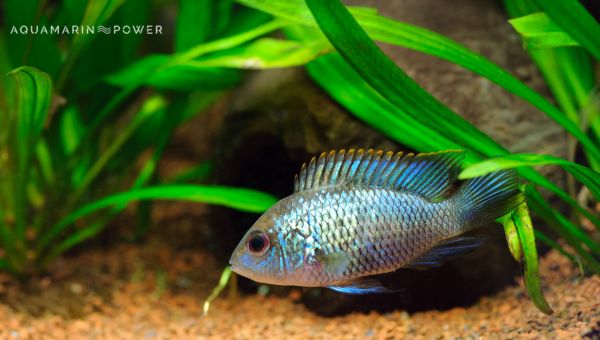
The electric blue acara will do well with a variety of live plants. Some good plants to use are Anubias, Java fern, and Cryptocoryne. They will help to keep the tank clean and provide a hiding place for the fish.
Filtration
The electric blue acara does well with a variety of filtration methods. You can use the following:
- Sponge filter- this type of filter is good for small tanks. You can also use an activated carbon filter or a mechanical filter.
- Hang-on-back filter- this type of filter is suitable for larger tanks.
- Under gravel filter- this type of filter is suitable for tanks with many plants.
Substrate and Gravel
The electric blue acara does well with a variety of substrates and gravel. Some good choices are:
- Flat river rocks- these are good for tanks that have a lot of plants.
- Marble- this is a good choice for tanks with many colors.
- Gravel- This is the most common type of substrate, and it is suitable for most tanks.
Ammonia Levels and Nitrite Levels
The ammonia levels for the electric blue acara should be kept at 0 ppm. You can use a test kit to check the levels. The story of ammonia must be checked after every water change.
The nitrite levels for the electric blue acara should also be kept at 0 ppm. You must use a test kit to check the decks after every water change.
Protein Skimmer
A protein skimmer is a device that removes proteins and other waste from the water. Using a protein skimmer is a good idea if you have an electric blue acara. If you use a protein skimmer, keep the levels at ten ppm.
Transportation and Handling
Using a fish transport bag when transporting the electric blue acara would be best. This will keep the fish safe and secure during transit.
You should also use water from the tank to keep the fish wet. When handling the electric blue acara, you should use a fishnet. Always support the fish’s body and never squeeze the fish.
Tank Mates
The electric blue acara can do well with a variety of tank mates. They can be kept with other fish that have similar care requirements. They can also be controlled with fish that are larger. Some good tank mates for the electric blue Acara include:
- Angelfish
- Betta
- Cichlids
- Goldfish
- Gourami
- Tetra
Breeding
The electric blue acara can be bred in a variety of ways. One way is to use a breeder net. You can also use an egg-laying net or a hatching net. The eggs will hatch in about three days. The females and the males will both care for the fry. Carrying the fry in the mouth is a common practice for cichlids.
Conditioning The Parents
The parents of the electric blue acara should be conditioned before breeding. This will help to ensure that they are healthy and fertile. You can prepare the parents by feeding them a diet of live food.
How to promote breeding?
The best way to promote breeding is to keep the water conditions perfect and provide many places for the fish to hide. You can also add some spawning mops or plants to the tank. You should also increase the water temperature to about 79° to 82° F. This temperature works the best to promote breeding.
Gestation Period and Larvae
The gestation period for the electric blue acara is about three weeks. The larvae will be about one-half inch long when they hatch. They can eat baby brine shrimp when they are about five days old.
Eggs and Fry
The eggs of the electric blue acara are white. They will be about one-quarter inch in size. The fry will be black when they first hatch.
They will grow to be about one inch long. The electric blue acara lays eggs every twenty-eight days. They lay around 150 to 200 eggs per spawn.
Growing Up
The fry can be kept in a variety of ways. You can keep them in a fry tank, or you can put them in a community tank. If you keep them in a fry tank, use an air stone and a heater. The temperature should be around seventy-eight degrees Fahrenheit.
You should also use a filter for the fry tank. The fry can be fed baby brine shrimp, crushed flake, and powdered food. The electric blue acara will reach full maturity in about two years. They can live for up to six years.
How many electric blue Acaras can be kept in one tank?
The recommended number of Electric Blue Acaras that can be kept in one tank is one. They are territorial fish and will defend their territory against other fish.
If you have more than one, they may not get along. You may also want to consider the size of the tank. The larger the tank, the more fish you can have.
Diseases They Can Have
The electric blue acara can have a variety of diseases. Some of the most common conditions are:
- Ich- This is a parasitic disease. In this disease, the fish will have white spots on their body.
- Fin Rot- This bacterial infection causes the fins to rot. The likely symptoms are redness and inflammation around the fins.
- Hexamita is a protozoan parasite that can cause weight loss, lethargy, and sometimes, death.
- Dropsy- This bacterial infection causes the fish to swell up.
- Flukes- These are parasites that can cause skin damage, listlessness, and in some cases, death.
- Trichodina- This is a protozoan parasite that causes the fish to have a reddish film on their body.
How to Treat Diseases?
You can treat diseases in your electric blue acara in several ways. Some of the most common treatments are:
- Salt- Adding salt to the water can help to kill some bacteria and parasites.
- Aquarium Antibiotics– Antibiotics can help to treat bacterial infections.
- Aquarium Medications- Several medications can help to treat various diseases in fish.
The veterinarian can help to diagnose the disease and prescribe the appropriate treatment.
Advantages of having them in your tank
- The electric blue acara is a beautiful fish that can add color to your tank.
- They are also hardy fish and can be easy to care for.
- They are good fish for beginner fish keepers.
- They can also be kept in a community tank with other fish.
Disadvantages of having them in your tank
- The electric blue acara can be territorial and may not get along with other fish.
- They can also be aggressive to smaller fish.
- They can also be susceptible to a variety of diseases.
- If you are not experienced in fish keeping, starting with an easier fish to care for is best.
Conclusion
The electric blue acara is a beautiful fish that can add color to your tank. They are hardy fish and can be easy to care for. They are good fish for beginner fish keepers. They can also be kept in a community tank with other fish. This freshwater fish is sure to add a new spark to your tank.
They are very human-friendly fish, and you will often see them as they come to greet you. They can indeed become a part of your tank, but it is advisable to understand this fish species properly before adding them.
Do your research well before making this fish your pet. We hope this article helped you know the electric blue acara better!


